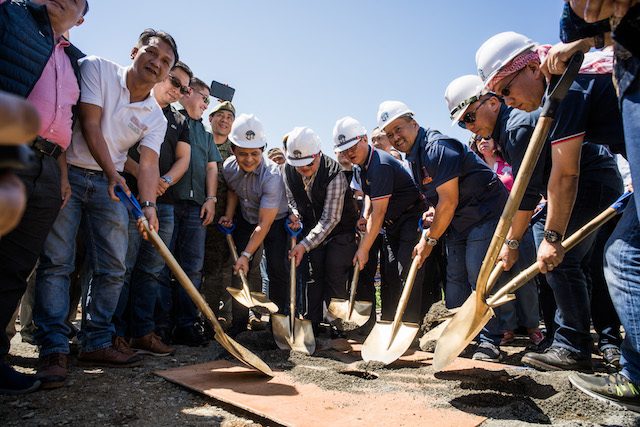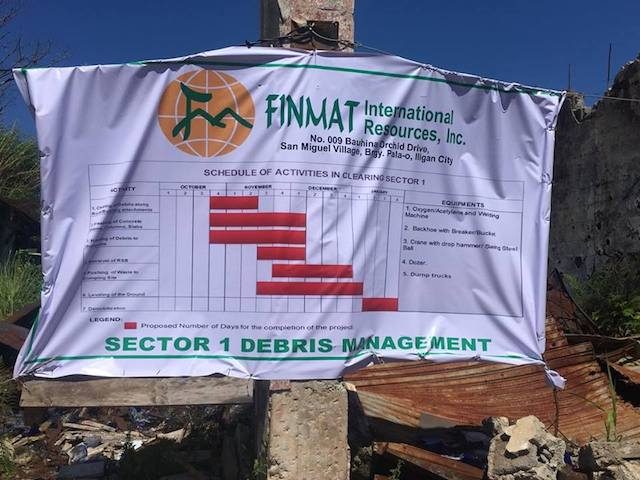SUMMARY
This is AI generated summarization, which may have errors. For context, always refer to the full article.

MANILA, Philippines – “Our long wait has finally come to an end,” said Marawi City Mayor Majul Gandamra on Tuesday, October 30.
That windy day, the groundbreaking ceremony marking the start of the rehabilitation of Marawi City’s most devastated area was finally held, after 4 months of delay.
The groundbreaking takes place more than a year after President Rodrigo Duterte declared the liberation of the city from terrorists on October 17, 2017.
Gandamra spoke for his constituents when he described how “harrowing” the past months had been for them. He described the “pain of uncertainty,” not knowing if his city could ever be rebuilt.
He also voiced the hope that the groundbreaking brings.
“In a few years from now, we hope to see a beautifully and strongly rebuilt Marawi City which shall be the pride of all Maranao people,” he said, to applause.
Behind him were national and local government officials, led by Task Force Bangon Marawi (TFBM) chairman Secretary Eduardo del Rosario.
Duterte, for whom the groundbreaking date was moved, was noticeably absent. TFBM’s Falconi Millar had told Rappler that the ceremony was supposed to be on October 31 so Duterte could make it. But the task force decided to move it a day earlier when they were told by Malacañang staff that “there has been changes in the schedule” of Duterte.
But regardless of who made it to Marawi that day, the groundbreaking ceremony marks a crucial milestone for the ravaged city.
What happens now? The Tuesday ceremony means they can now expect construction work inside the Most Affected Area (MAA), the 250-hectare part of Marawi that sustained the most damage during the 5-month siege by terrorists.
“This will mark the start of the rapid development inside the Most Affected Area. The reconstruction of Marawi City as promised by PRRD starts today,” said Housing and Urban Development Coordinating Council (HUDCC) Secretary-General Falconi Millar during the ceremony.
The rehabilitation will be done in phases. TFBM has divided the areas for reconstruction in “sectors.”
Philippine firm FINMAT International Resources, Incorporated (FIRI) was tapped by the government to do the first phase of debris clearing in “sector 1.” Their contract for this job is worth P75 million, Del Rosario earlier told media.
Based on a tarpaulin in Marawi showing their scope of work, FINMAT estimates it will finish the work in January 2019.

Can the Marawi residents go back to their houses now? Not yet. The task force wants complete debris management and the construction of some facilities before allowing the return of people to houses inside the MAA.
But Millar said residents can return to their homes before the year 2020.
“The return to your homes that you are expecting, the rebuilding of your homes here in the MAA will happen before the year 2020,” he said in Filipino.
Del Rosario, meanwhile, said residents can start rebuilding their houses in mid-2020.
“Once we have completed the debris management and road expansion in sector 1, 2 and 3 and everything is clear for the residents to construct their houses, then we will allow you to start building your houses. And in our estimate it will be in the middle of 2020,” he said.
What can we expect from rehabilitation? The groundbreaking means the government can now begin work on the first 5 components of the 22-component rehabilitation plan.
Millar explained this onstage during the groundbreaking ceremony.
The first 5 components are:
- Debris management
- Road infrastructure and underground facilities (telecommunication, electrical wiring will be underground)
- Road widening
- Acquisition of road right of way
- Master development plan with feasibility study
The very first step after the ceremony is the debris management for “section 1,” an area with 411 houses, he said.
Debris management is necessary to ensure the MAA is cleared of any dangerous objects, including explosives, so that construction can proceed safely.
After the first 5 components, residents of Marawi can expect the construction of new structures, such as new barangay halls with madrasahs in all 24 affected barangays, a grand central market, and a Marawi museum and “school of living tradition.”
These are some buildings or facilities that TFBM wants developers to build in Marawi:
- Agus River and Lake Lanao promenade
- 24 barangay halls with madrasah and health centers
- Grand central market
- Port facilties
- Multi-transport hub
- Rebuilding of elementary and high school
- Memorial site
- Convention center
- Preservation of 3 historical sites
- Marawi museum and school of living tradition
Millar also promised that no Marawi resident will be displaced because of the rehabilitation and development efforts.
“No displacement will happen and Task Force Bangon Marawi will not forcibly take any land. That’s our promise to you,” he said.
He gave assurances that Islamic and cultural sensitivities of the Maranaos is the “foremost consideration” of the task force.
The Marawi ground zero groundbreaking was originally scheduled to take place in June. The months after brought repeated postponements because of challenges in pinning down qualified developers and the discovery that the plan to use joint venture agreements as a mode to tap developers is not applicable to the project. – Rappler.com
Add a comment
How does this make you feel?
There are no comments yet. Add your comment to start the conversation.